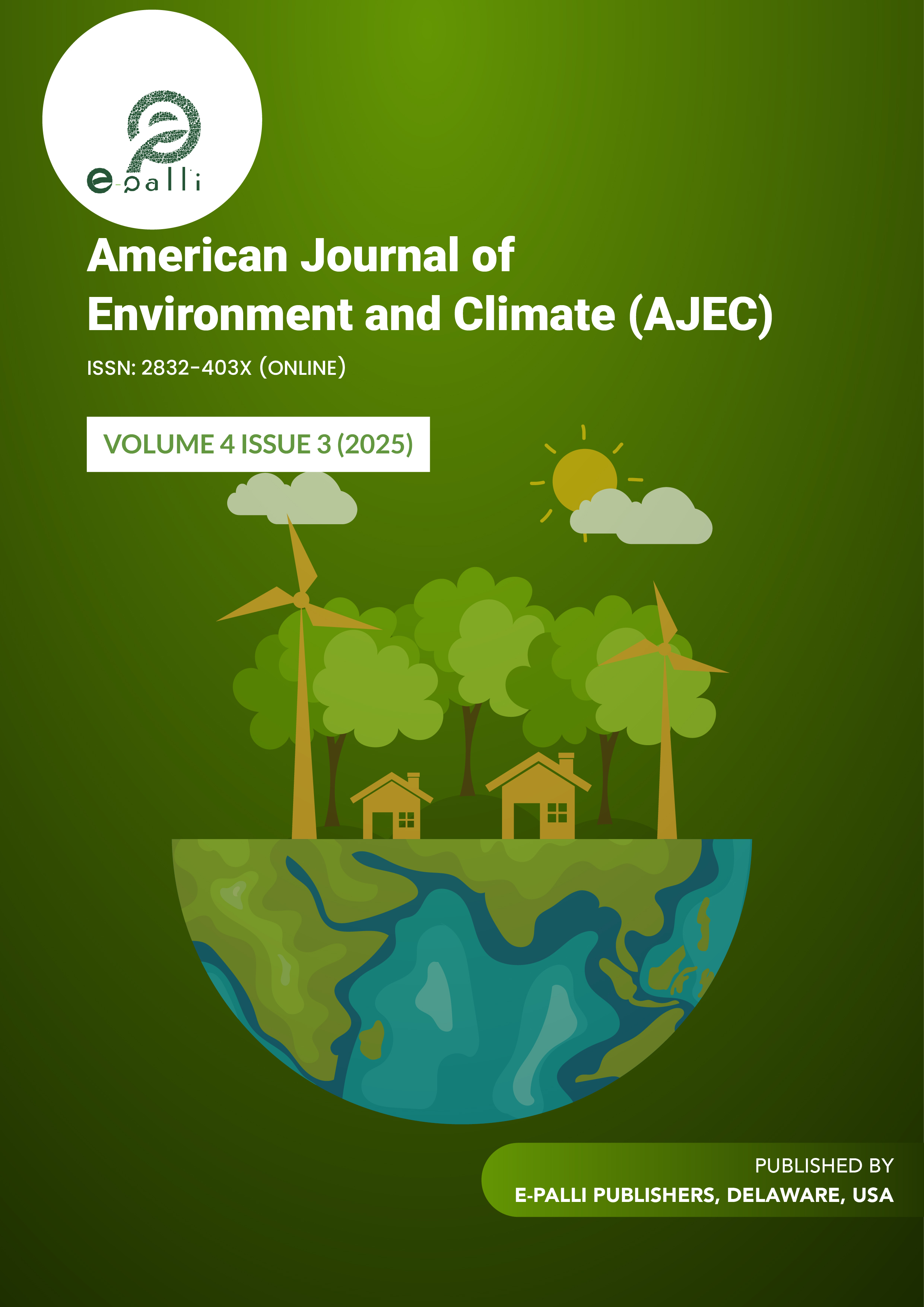A Climate Action Roadmap for GHG Reduction in the Textile Industry: Pathway to Sustainability
DOI:
https://doi.org/10.54536/ajec.v4i3.6009Keywords:
GHG Emissions Reduction, Renewable Energy, Sustainability Framework, Textile Industry, PathwayAbstract
The textile industry is one of the major contributors to greenhouse gas (GHG) emissions and countries like Bangladesh are among the key hubs of this industry in the developing world. Therefore, adopting sustainable strategies in these countries is essential for environmental protection and long-term economic resilience. In our study, a comprehensive Climate Action Roadmap (CAR) has been developed with the baseline year of 2018, aiming to reduce greenhouse gas emissions by 50% by 2030. This roadmap is designed to identify and quantify both direct and indirect GHG emissions, while evaluating energy consumption, production processes and waste management practices, thereby clearly highlighting areas for improvement. Innovative technologies and process enhancements, including the adoption of renewable energy (solar and wind) alternative heating methods and efficiency-driven production strategies-have been integrated into this roadmap strategy to support significant emission reductions. This roadmap has incorporated Collaboration and Best Practices Sharing into its framework in order to ensure stakeholder engagement, accountability and progress monitoring for effective implementation in the operations of any textile industry around the world, including Bangladesh. The CAR framework will undoubtedly make an important contribution to GHG reduction by providing practical strategies to reduce environmental impacts while promoting social responsibility and sustainable economic growth. This framework provides to the textile industry a methodical and efficient route to sustainability by methodically tackling energy efficiency, clean energy integration and performance optimization. Through a thorough evaluation of textile GHG profiles and emission calculation techniques, EQMS Consulting Limited was able to create and validate this framework. The firm has also applied the CAR framework in five textile facilities with encouraging results.
Downloads
References
Abdel-Dayem, A. M., & Mohamad, M. A. (2001). Potential of solar energy utilization in the textile industry — a case study. Renewable Energy, 23(3-4), 685–694. https://doi.org/10.1016/s0960-1481(00)00154-3
Ahmed, S., Ahsan, N., Alam, S. S., & Kokash, H. A. (2025). Advancing Circular Economy Implementation in Malaysian SMEs: The Role of Financial Resources, Operational Alignment, and Absorptive Capacity. Circular Economy and Sustainability, 5, 2843–2871. https://doi.org/10.1007/s43615-025-00533-3
Burtraw, D., Sweeney, R., & Walls, M. (2008). The Incidence of U.S. Climate Policy: Where You Stand Depends on Where You Sit. SSRN Electronic Journal. https://doi.org/10.2139/ssrn.1272667
Cragg, M. I. (2009, May). Carbon Geography: The Political Economy of Congressional Support for Legislation Intended to Mitigate Greenhouse Gas Production. NBER Working Papers; National Bureau of Economic Research, Inc. https://ideas.repec.org/p/nbr/nberwo/14963.html
Filho, W. L., Perry, P., Heim, H., Dinis, M. A. P., Moda, H., Ebhuoma, E., & Paço, A. (2022). An overview of the contribution of the textiles sector to climate change. Frontiers in Environmental Science, 10(1), 1–5. https://doi.org/10.3389/fenvs.2022.973102
Filonchyk, M., Peterson, M. P., Yan, H., Gusev, A., Zhang, L., He, Y., & Yang, S. (2024). Greenhouse gas emissions and reduction strategies for the world’s largest greenhouse gas emitters. Science of the Total Environment, 944(0048-9697), 173895–173895. https://doi.org/10.1016/j.scitotenv.2024.173895
Geissdoerfer, M., Savaget, P., Bocken, N. M. P., & Hultink, E. J. (2017). The Circular Economy - a New Sustainability paradigm? Journal of Cleaner Production, 143(1), 757–768. https://doi.org/10.1016/j.jclepro.2016.12.048
Greening global value chains: Textile sector decarbonization in Bangladesh. (2025). United Nations Conference on Trade and Development (UNCTAD). https://unctad.org/system/files/non-official-document/-smep-ghg_01-08-2025.pdf?utm_source=chatgpt.com
Jalonen, H., Tuominen, S., Ryömä, A., Haltia, J., Nenonen, J., & Kuikka, A. (2018). How Does Value Creation Manifest Itself in the Nexus of Sport and Business? A Systematic Literature Review. Open Journal of Business and Management, 06(01), 103–138. https://doi.org/10.4236/ojbm.2018.61008
Marinina, O., Kirsanova, N., & Nevskaya, M. (2022). Circular Economy Models in Industry: Developing a Conceptual Framework. Energies, 15(24), 9376. https://doi.org/10.3390/en15249376
Mulyasari, G., Djarot, I. N., Sasongko, N. A., & Putra, A. S. (2023). Social-life cycle assessment of oil palm plantation smallholders in Bengkulu province, Indonesia. Heliyon, 9(8), e19123. https://doi.org/10.1016/j.heliyon.2023.e19123
Niinimäki, K., Peters, G., Dahlbo, H., Perry, P., Rissanen, T., & Gwilt, A. (2020). The Environmental Price of Fast Fashion. Nature Reviews Earth & Environment, 1(4), 189–200. https://doi.org/10.1038/s43017-020-0039-9
Pollak, M., Meyer, B., & Wilson, E. (2011). Reducing greenhouse gas emissions: Lessons from state climate action plans. Energy Policy, 39(9), 5429–5439. https://doi.org/10.1016/j.enpol.2011.05.020
Rahaman, Md. T., Pranta, A. D., Repon, Md. R., Ahmed, Md. S., & Islam, T. (2024). Green Production and Consumption of Textiles and Apparel: Importance, Fabrication, Challenges and Future prospects. Journal of Open Innovation, 10(2), 100280–100280. https://www.sciencedirect.com/science/article/pii/S219985312400074X
Rausch, S. (2010, June). Distributional Implications of Alternative U.S. Greenhouse Gas Control Measures. NBER Working Papers; National Bureau of Economic Research, Inc. https://ideas.repec.org/p/nbr/nberwo/16053.html
Silvério, A. C., Ferreira, J., Fernandes, P. O., & Dabić, M. (2023). How does circular economy work in industry? Strategies, opportunities, and trends in scholarly literature. Journal of Cleaner Production, 412, 137312. https://doi.org/10.1016/j.jclepro.2023.137312
Tang, A. Q., & Mizunoya, T. (2021). A Study on Selecting Greenhouse Gas Reduction Options: A Simulation Analysis for Vietnam. Sustainability, 13(24), 13530. https://doi.org/10.3390/su132413530
Upadhyay, A., Laing, T., Kumar, V., & Dora, M. (2021). Exploring barriers and drivers to the implementation of circular economy practices in the mining industry. Resources Policy, 72, 102037. https://doi.org/10.1016/j.resourpol.2021.102037
Downloads
Published
How to Cite
Issue
Section
License
Copyright (c) 2025 Kazi Farhed Iqubal, Tauhidul Hasan, Md. Zahidul Islam, SK. Salahuddin Ahammad, Nasim Khan, Ahmed Jubaer, Sk Abid Md Saad, Digonta Chanda

This work is licensed under a Creative Commons Attribution 4.0 International License.








